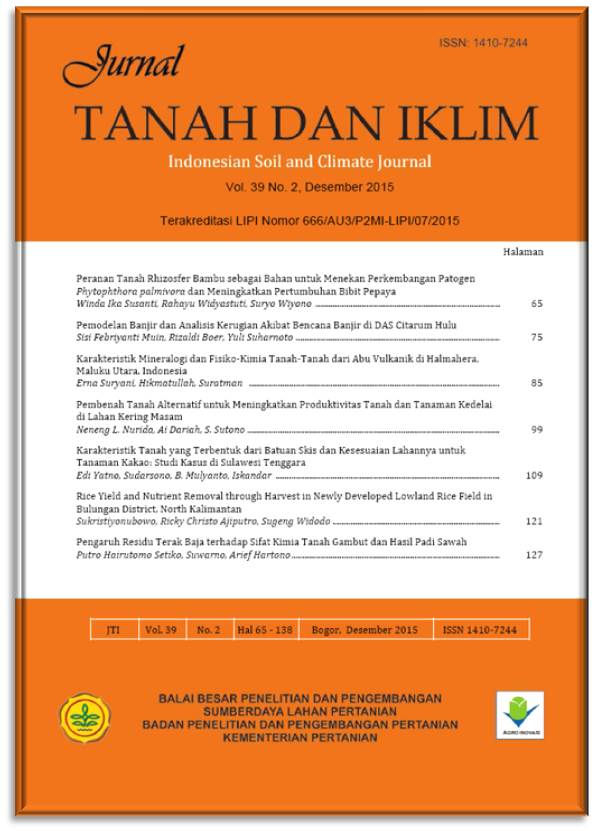Rice Yield and Nutrient Removal through Harvest in Newly Developed Lowland Rice Field in Bulungan District, North Kalimantan
Keywords:
Rice yield, Nutrient removal, Nitrogen, Phosphorus, Potassium, Harvest product, Newly developed lowland rice field,Abstract
Abstract. Nutrient removal through rice harvest of Ciherang variety planted in newly developed lowland rice field was studied in Bulungan District, in 2013. The aims of this research were to evaluate the amount of nutrients taken out by rice harvest and to properly manage its fertility to sustain high rice yield. Five treatments were tested, T0: Farmers practices, T1: Package A (NPK at recommendation r ate + Dolomite), T2: Package B (NPK at recommendation rate + dolomite + Compost + Smart), T3: Package C (¾ NPK at recommendation rate + Compost + Dolomite + Smart), and T4: Package D (NPK at recom-mendation rate + Compost + Dolomite + Smart). They were arranged in a Randomized Complete Block Design and replicated three times. The results showed that the highest rice biomass yield (rice grains, rice straw and rice residues) was from the package D, whereas, the highest concentrations of N, P, and K were found in rice grain of Package B. The highest nitrogen and phosphorous removals were from rice grains and for potassium was from rice straw. Depending on the treatments, total nutrient removal through rice grains and rice straw varied: from 30.96 ± 2.93 to 67.82 ± 8.93 kg of N; 12.83 ± 2.15 to 27.53 ± 14.11 kg of P; and 55.10 ± 2.92 to 101.84 ± 6.02 kg of K ha-1 season-1. To avoid nutrient mining and to maintain the soil fertility, about 67 to 150 kg urea, 65 to 140 kg SP-36 and 105 to 196 kg KCl ha-1 season-1 should be applied to the soil.
ÂÂÂÂ
Abstrak. Unsur hara yang terangkut oleh hasil panen padi varitas Ciherang yang ditanam pada sawah bukaan baru dipelajari dan diteliti di Kabupaten Bulungan, Kalimantan Utara pada tahun 2013. Penelitian bertujuan untuk mengetahui unsur hara yang diangkut oleh hasil panen dan untuk meningkatkan status unsur hara agar diperoleh hasil padi yang tinggi. Lima macam perlakuan dibandingkan, T0: Kebiasaan Petani, T1: Paket A (NPK dengan dosis rekomendasi + Dolomit), T2: Paket B (NPK dengan dosis rekomendasi + dolomit + kompos jerami + Smart), T3: Paket C (¾ dosis rekomendasi NPK + kompos jerami + Dolomit + Smart), dan T4: Paket D (NPK dengan dosis rekomendasi + kompos jerami + Dolomit + Smart). Perlakuan disusun berdasarkan Rancangan Acak Kelompok yang diulang tiga kali. Hasil penelitian menunjukkan bahwa hasil brangkasan padi (gabah, jerami dan sisa tanam padi) tertinggi diperoleh pada perlakuan paket D. Sebaliknya, konsentrasi N, P dan K tertinggi diperoleh pada paket B. Kehilangan N dan P tertinggi adalah yang terangkut bersama hasil gabah dan kehilangan K tertinggi terangkut bersama jerami padi. Tergantung pada perlakuannya, total unsur hara yang diangkut oleh hasil gabah dan jerami padi bervariasi antara 30,96 ± 2,93 sampai 67,82 ± 8,93 kg untuk N; 12,83 ± 2,15 sampai 27,53 ± 14,11 kg untuk P; dan 55,10 ± 2,92 sampai 101,84 ± 6,02 kg untuk K ha-1 musim-1. Untuk menghindari pengurasan unsur hara dan menjaga kesuburan tanah, maka diperlukan penambahan 67 sampai 150 kg urea, 65 sampai 140 kg SP-36 dan 105 sampai 196 kg KCl ha-1 musim-1.


